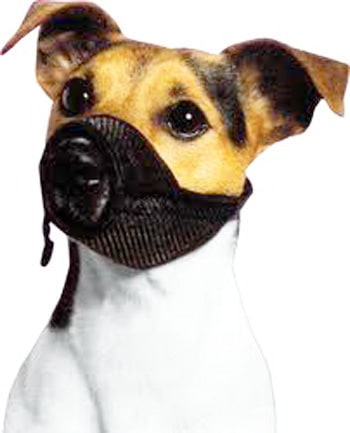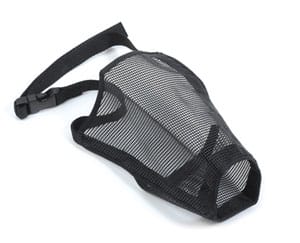How To Introduce A Muzzle To A Dog
Muzzle Training a Dog
It is vital that your dog perceives the muzzle as a positive experience. Quite often the dog’s first encounter with a muzzle is in a stressful and fearful situation,
This could be at the Vets, when the dog may become aggressive or difficult to handle because of fear, panic or injury. It is therefore prudent to introduce a dog to a muzzle over a period of time, irrespective of whether you ever intend to muzzle.
Remember a muzzle may be a necessity at sometime during the dog’s life. Click on the muzzle on the right, to go to my shop Therefore you should introduce this aid in a non-confrontational positive manner before you need one. All my dogs are muzzle trained despite never having to use one yet.
Which One to Choose
Depending on what muzzle you are using, there are numerous on the market, ranging from the Baskerville type which is normally either a plastic or rubber type, canvas or a mesh muzzle. The one I normally prefer is a ‘mesh muzzle’, which has tiny pinpricks that stop it overheating of the skin, and allows treats to be fed directly into the dog’s mouth.
This type seems to be acceptable to most dogs. click on the image above for more information on sizes or to purchase a muzzle.

Introducing the Muzzle
Irrespective of which type you choose, you must make the experience rewarding and positive. Most dogs will not be over happy with this type of restriction. We are therefore going to use treats and a gradual desensitisation program.
Initially just take out the muzzle and let the dog sniff it ,then treat and praise; I always use Dried Sprats for this as they are a great totally natural treat. Brilliant for the coat with essential oils and Omega 3.
They also smell great, you can also break the Sprats into any size you want very easily, because they are air dried. After allowing the dog to just sniff treat and praise a number of times, putting the muzzle away in between,.
Then either hold a titbit up to the open end of the muzzle and bring it up to the dog’s nose, or if a Baskerville drop the treat inro inside.
The dog will smell the food and press forward to get at the titbit, pushing its face a little bit into the muzzle, when he does this either roll or push the treat toward the dog in the inside of the muzzle and praise.
Do this on a number of occasions over another day or so. Then do the same thing but gently slide the muzzle a little way over the nose so he can get the treat, easier then immediately remove it praising at the same time.
Do this regularly but never attaching the muzzle or forcing the issue at this time. You can use a word like good, or even muzzle whilst you are sliding it over the nose.
Continue these exercises over a number of days in different places in the house and garden, say 4/5 times a day, if possible. After 4 or 5 days actually clip the muzzle on for a few seconds, then take it off immediately. Do this on a number of occasions gradually increasing the time the muzzle is left on from seconds to minutes then longer.
Make sure it is not too restrictive and tight around the mouth and nose as this can restrict drinking and breathing and could distress the dog. I do not recommend muzzles for anxiety related problems such as separation anxiety, whereby the dog is destructive, or for barking or howling problems, there are much safer and more appropriate techniques for these types of behaviour. Never leave the muzzle on for long periods and always supervise the dog when he is wearing one.
The use of a muzzle can be advantageous in a number of circumstances:
1. In certain veterinary procedures a muzzle may be required
2. When introducing another dog or puppy into the household.
3. In cases of pain related temporary aggression.
4. When introducing cats and other animals.
5. Certain breeds are required by law, other breeds may be added to the list in the future.
6. Some behavioural modifications or training procedures may require a muzzle
Whatever the reason, the earlier you introduce a Muzzle the easier it will be to accept. I muzzle train all my dogs when puppies. For instance when taking blood tests or they are injured and need handling or manipulation or when they are in pain.
None of my dogs have ever shown aggression or bitten either a dog or a human. That is not the point, I still feel more comfortable knowing if they need one it will not need to be forced on them when they are injured, hurt or fearful. A muzzles can be very helpful when desensitising a fearful or aggressive dog to certain situations., such as children or other dogs,
If you need the muzzle for outside and the dogs run a lot then a Baskerville one would be the best.







